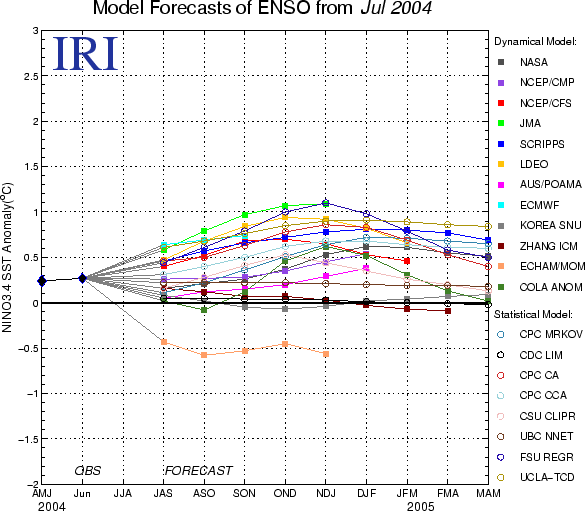Current ENSO Information
| ENSO Quick Look |
| IRI ENSO Update |
| Technical ENSO Update |
| Summary of Model Forecasts |
Summary of ENSO Model Forecasts
15 July 2004
| > | Note on interpreting model forecasts |
| > | Discussion of current forecasts |
| > | Figure of Nino3.4 SST forecasts |
| > | Table of Nino3.4 SST forecasts |
| > | Notes on the data |
Note on interpreting model forecasts
The following graph and table show forecasts made by dynamical and statistical models for SST in the Nino 3.4 region for nine overlapping 3-month periods. Note that the expected skills of the models, based on historical performance, are not equal to one another. The skills also generally decrease as the lead time increases. Thirdly, forecasts made at some times of the year generally have higher skill than forecasts made at other times of the year--namely, they are better when made between June and December than when they are made between February and May. Differences among the forecasts of the models reflect both differences in model design, and actual uncertainty in the forecast of the possible future SST scenario.Discussion of current forecasts
The set of dynamical and statistical model forecasts issued during late June and early July 2004 shows a range of possible sea surface temperature conditions for the coming 2 to 10 months (July - August - September 2004 through March - April -May 2005). Most models are indicating either near-neutral conditions over the coming several seasons, or the development of weak El Nino conditions.
Table 1. Forecast SST Anomalies (deg C) in the Nino 3.4 Region
| Seasons (2004-05) | |||||||||
|---|---|---|---|---|---|---|---|---|---|
|
|
|
|
|
|
|
|
|
|
FMA |
| Dynamical models | |||||||||
|
|
|
|
|
|
|
|
|
|
|
|
|
|
|
|
|
|
|
|
|
|
|
|
|
|
|
|
|
|
|
|
|
|
|
|
|
|
|
|
|
|
|
|
|
|
|
|
|
0.7 | 0.8 | 0.8 | 0.8 | 0.8 | 0.7 |
|
|
|
|
|
|
|
|
|
|
|
|
|
|
|
|
|
|
|
|
|
|
|
|
|
|
|
|
|
||||
|
|
|
|
|
|
|
|
|
0.1 | 0.1 |
|
|
0.2 |
0.1 | 0.1 |
|
|
|
|
-0.1 | |
|
|
|
|
|
|
|
|
|
|
|
|
|
|
|
|
|
|
|
|
|
|
|
|
|
|
|
|
|
|
|
|
|
| Statistical models | |||||||||
|
|
|
|
|
|
|
|
|
|
|
|
|
|
|
|
|
|
|
|
|
|
|
|
|
|
|
|
|
|
|
|
|
|
|
|
|
|
|
|
|
|
|
|
|
|
|
|
|
|
|
|
|
|
|
|
|
|
|
|
|
|
|
|
|
|
|
|
|
|
|
|
|
|
|
|
|
|
|
|
|
|
|
|
|
|
|
|
|
|
|
|
|
|
|
|
|
|
|
|
|
|
|
|
|
|
|
|
|
|
Notes on the data
Only models producing forecasts on a monthly basis are included. This means that some models whose forecasts appear in the Experimental Long-Lead Forecast Bulletin (produced by COLA) do not appear in the table.The SST anomaly forecasts are for the 3-month periods shown, and are for the Nino 3.4 region (120-170W, 5N-5S). Often, the anomalies are provided directly in a graph or a table by the respective forecasting centers for the Nino 3.4 region. In some cases, however, they are given for 1-month periods, for 3-month periods that skip some of the periods in the above table, and/or only for a region (or regions) other than Nino 3.4. In these cases, the following means are used to obtain the needed anomalies for the table:
- Temporal averaging,
- Linear temporal interpolation
- Visual averaging of values on a contoured map
- Regional SST anomaly adjustment using the climatological variances of one region versus that of another
The anomalies shown are those with respect to the base period used to define the normals, which vary among the groups producing model forecasts. They have not been adjusted to anomalies with respect to a common base period. Discrepancies among the climatological SST resulting from differing base periods may be as high as a quarter of a degree C in the worst cases. Forecasters are encouraged to use the standard 1971-2000 period as the base period, or a period not very different from it.
ENSO Diagnostics & Prediction Info Archive